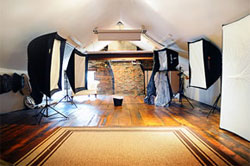Bernie Griffiths is a photography business coach, and he is certain the service he offers to wedding, portrait and family photographers is unique, with no one else in the world doing it quite like he does.
 Bernie (pictured right) operates a photography coaching business with an emphasis on marketing strategies and creating successful business models. But what separates him from the touring seminars and other business coaches is that he corresponds one-on-one on a weekly basis with all his clients, and tailors the coaching program around photographers and their businesses.
Bernie (pictured right) operates a photography coaching business with an emphasis on marketing strategies and creating successful business models. But what separates him from the touring seminars and other business coaches is that he corresponds one-on-one on a weekly basis with all his clients, and tailors the coaching program around photographers and their businesses.
‘The way I do the coaching is one-on-one. I don’t do group coaching or send a bunch of generic videos to clients. It’s a weekly, one-on-one ‘face-to-face’ Skype session,’ he told ProCounter. ‘What I offer is quite unique within the industry. Photographers running marketing seminars only teach others based on their own business and what has worked for them.
‘But every photographer comes from a different place, has different clientele, style, skill, and expectations. So I extract information and implement a pricing, selling, and photography structure for that particular business.’
Bernie opened his first and only wedding and portrait studio in Melbourne back in 1969 when he was 23, only to sell it three years ago when he decided a career change was in order. He doesn’t claim to have been overly skilled with a camera, but was in tune with how to market and promote his business. That’s what he sees as an art.
Because Kodak and other industry-related businesses sponsored his seminars during his photography career, becoming a full-time photography business coach seemed like a natural next step. And given his business was successful for a long timer, he figured a few tricks he learned along the way could be shared to help others make more money.
The vast majority of the 65 clients he has coached in the last three years are from Australia and New Zealand. Some are masters of photography looking to freshen up their business whereas others are completely new to the industry.
In total he estimates around $1 million in profit has been generated for clients with his assistance.
The coaching is done in either a six or 12-month program which involve a weekly hour-long session. Specific tasks for the photographer are set, and those taking the 12-month program have a two-day visit from Bernie – be it in a studio, or a desk and chair crammed in the corner of a home office.
Given Bernie believes no two businesses are the same, it can be difficult for him to be specific about challenges wedding and portrait photographers face. However he’s noticed a few areas where photographers can improve: ‘New photographers generally fall short because of their ‘non-actions,’ he said.
‘They have to learn a lot of new skills – as I did when I became a full-time coach. First and foremost they have to know how to use their camera and post-processing software, but there is also an art in learning how to market, and sometimes I find they don’t follow through with actions.’
What he means is that photographers aren’t reading the ‘business manual’. Instead, and like many of us, they just hastily rip open the box, throw the instruction manual aside and try to figure it out on their own. Only later, after a few mistakes, will they come back to it and take the time to learn how to run a business.
Bernie makes photographers accountable for their business, he said. Here he is with Fi Mims at her studio in St. Kilda, Melbourne.
Spending less is more
When it comes to marketing, Bernie recommends spending as little money as possible. The best way to do this is by posting consistently on social media to draw attention to the brand. It’s cost-effective but obviously has limited reach and, frankly, everyone does it.
But marketing can also be a little more creative.
‘Starting a third party alliance with a business or organisation can be really handy and cheap, and I’ve noticed a lot of the successful, big studios do this. Let’s use car dealerships as an example,’ he said.
‘Make an agreement where each time the local dealership sells a car, have them send the customer a letter saying “As a thank-you we’ve organised a family portrait session with the area’s leading portrait photographer, with a print included at the value of $600”.’
But strategically targeting the right market is important. A photographer at the high-end of the market will yield better results by partnering with a Mercedes or Lexus dealership than, say, a Holden or Toyota dealership. Someone like Yervant or Rocco Ancora would be best suited with a Maserati or Ferrari dealer – ‘targeting is everything’.
For photographers in regional areas of Australia in particular, these strategies can prove hugely successful once word-of-mouth spreads.
New and up-and-coming wedding photographers often base their pricing off what others are doing – but that’s not always a wise strategy!
Perceived value creates opportunities
Pricing is another area Bernie finds photographers struggle with because, again, many base it on what other photographers recommend.
He suggests to clients that they adopt a system of collections or packages, ‘perceived value is very important and creates opportunities to upsell’.
‘One of my client’s wedding packages averages around $10,000. He does this because he only does albums – no shoot-and-burn coverages. His incoming price is around $3000, but when the clients come in for the album design he sells about $7000 more. He uses the files at a lever to encourage clients to go with the upgrade.’
Given customers cannot resist the temptation of digital files, making the more expensive packages the ones with digital files can push a client to spend more.
‘It’s common for clients to specifically want digital files rather than prints. It’s a product that they want,’ he said. ‘So knowing that, perhaps offer prints in the cheaper collections, and then offer some files in the slightly more expensive collection. And the fourth collection – the most expensive – offer all the files. We know what the consumer wants, and if that’s files, we can encourage them up the ladder so they spend more money.’
Resist the trends!
Lastly he thinks too many photographers – particularly those entering the industry as part-time professionals – tend to copy or mimic other photographers, rather than testing out what works for them.
When it comes to things like shooting style and locations, too many photographers follow the leader, making it harder for potential clients to differentiate one from the other. Ultimately they start making decisions based on prices.
At the moment the trend (latest fad?) among portrait photographers he’s noticed is to shoot at a client’s home with a documentary, black-and-white style. (Possibly because fewer photographers have their own studio and this keeps overheads low.)
Throughout his career Bernie said that when a trend emerged he’d resist it – when the majority started shooting portraits in the outdoors, he put more focus on the studio.
Bernie said he is currently running at 80 percent capacity with his coaching business.
He told ProCounter that not all photographers will benefit or be able to work with him and he will be upfront with a cashback guarantee.if that’s the case.
Photography Business Coach Bernie first appeared on ProCounter’s radar earlier this year when he was interviewed about National Family Portrait Month, a charity-based event he organised with the aim of raising the profile of professional family portraiture in Australia. (And… possibly his own business!)




